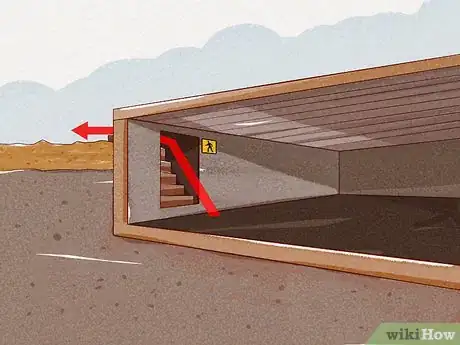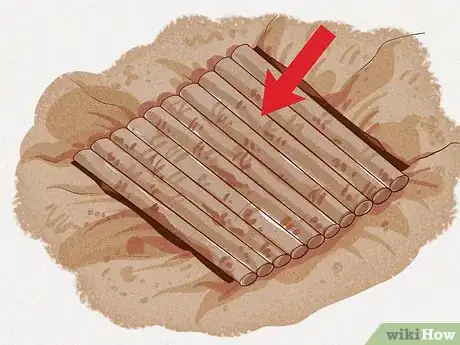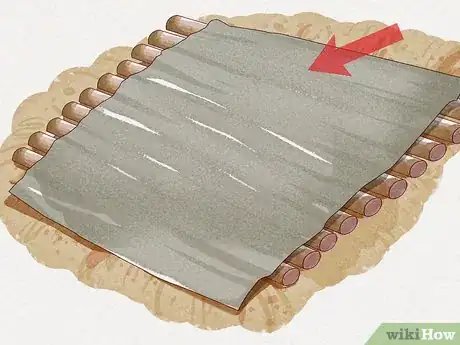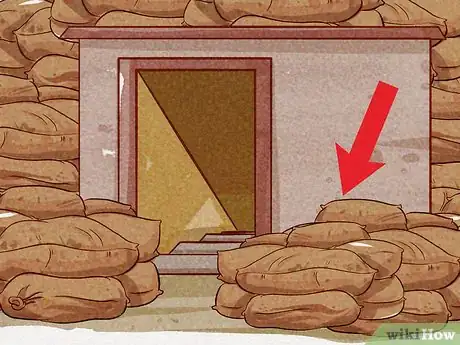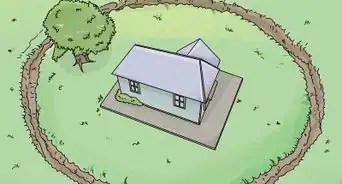This article was co-authored by wikiHow Staff. Our trained team of editors and researchers validate articles for accuracy and comprehensiveness. wikiHow's Content Management Team carefully monitors the work from our editorial staff to ensure that each article is backed by trusted research and meets our high quality standards.
There are 10 references cited in this article, which can be found at the bottom of the page.
wikiHow marks an article as reader-approved once it receives enough positive feedback. In this case, 83% of readers who voted found the article helpful, earning it our reader-approved status.
This article has been viewed 751,277 times.
Learn more...
While experts say nuclear war is unlikely, building a fallout shelter can still help provide peace of mind during these uncertain times. A nuclear fallout shelter, also called a bomb shelter, protects you and your family after a nuclear attack or disaster. You can begin building a simple shelter by digging a trench and covering it with roofing logs and dirt. This type of shelter, called a pole-covered trench shelter, is waterproof and radiation-resistant when constructed properly. Keep reading to learn for a step-by-step walkthrough on exactly how to build a fallout shelter at home.
Steps
Excavating the Soil
-
1Choose a building area on stable ground away from obstructions. When a nuclear weapon detonates, it creates a thermal pulse which can set things 20 mi (32 km) away on fire. You can often build a shelter in your backyard if you can position it so that both rainwater and water behind dams runs away from it. You will also need to consider where the utility lines are in your area so you don’t disturb them.[1]
- Try to select stable ground where trees and buildings won’t fall on your shelter. If you’re in a city, you can build a reinforced shelter in a basement. The concrete can protect you from fallout and falling debris.
- Research the topography of your area. Your government’s local land survey office will have them available. Also, check with the emergency response office.
- Avoid positioning your shelter downhill from bodies of water or below steep slopes. Keep it clear of flammable buildings.
-
2Print out a blueprint for the shelter you want to make. Having a clear blueprint will help you construct a stable, effective shelter. You can find some basic plans simply by searching for fallout shelter blueprints online. Some plans may even include a step by step overview for building the shelter.[2]
- You can also get blueprints by consulting an architect or drafter. They can provide guidance on what shelter best suits your needs. Most building construction companies can build a shelter for you.
- Even if you don’t want to hire someone to design a shelter, sketch your own plans before beginning construction. You can try using a computer program like SketchUp.
Advertisement -
3Stake out and clear the building area for construction. Plot out the shelter’s perimeter according to your blueprint. Plant a series of wooden stakes in the ground to outline the shelter’s perimeter. Then, use shovels, axes, and other tools to dig up grass, trees, rocks, and other debris in the area.[3]
- Clear the land about 10 ft (3.0 m) beyond the shelter’s perimeter so you have plenty of space to work with.
- The shelter’s size is up to you. Expect to add about 3 ft (0.91 m) to the shelter’s length for every person who will hide there. A basic 4-person shelter is about 10 × 10 × 10 ft (3.0 × 3.0 × 3.0 m) in size.
-
4Dig a trench and move the dirt out of the excavation area. Begin digging out soil to form the basic outline of your shelter. You can do this with shovels, although it takes a lot of time and labor. Move the excavated dirt 10 ft (3.0 m) beyond the stakes. You will need to keep the dirt away so it doesn’t fall back into the trench.[4]
- For quicker work, rent a backhoe from an equipment company near you. This can get pricey, but speeding up the excavation process is often worth it.
- Digging a deeper trench means more space and blast protection for your shelter.
-
5Create an emergency exit at the far end of the trench. The emergency exit will also serve as extra ventilation. At the end of the trench, dig a crawl space about 2 ft (0.61 m) wide and 3 1⁄2 ft (1.1 m) deep. The crawl space will be right below the soil’s surface. Create an exit at the end by digging a small trench to connect the crawl space to the outside world.[5]
- You can build dirt steps as needed to reach the surface. Pile dirt near the entryway, then begin digging into it with a shovel. Shape the dirt into small steps. Lay threshold boards over each steps, connecting them to side boards with 10 in (25 cm) lag bolts.
- Always have a second exit in your shelter to guard against emergencies.
-
6Make a second crawl-way for the entrance. Create the main entryway the same way you built the emergency exit. This time, dig on the opposite end of the shelter. You can make this entryway a little wider so you have an easier time entering the shelter. Keep the entryway below ground, emerging away from the shelter’s main living quarters.[6]
- The main entrance will not have air pumps or ventilation pipes running through it, so it may appear larger by default.
Creating the Shelter Roof
-
1Lay wooden roofing poles side by side over the trench. Get poles that overhang the trench by at least 2 ft (0.61 m) so they are less likely to collapse. Lay them across the trench’s width. Push the logs as close together as possible to reduce the gaps in the shelter’s roof.[7]
- For example, try using 9 ft (2.7 m) poles over a trench 5 ft (1.5 m) wide.
- Roofing poles are basically long, uncut pieces of timber. You can get them from lumber yards. Roofing suppliers and home improvement stores may also be able to help.
-
2Stack poles in front of the entryways to keep dirt out of them. Lay a few 6 ft (1.8 m) wooden roofing poles between the trench and the edge of each entryway. Use about 3 or 4 logs on each side. Tie them together with strong rope or wire, also binding them to the closest poles hanging over the trench.[8]
- These entryway poles hold back the dirt you will use to create the shelter ceiling. If you don’t have them in place, the dirt can slide into the entryways, blocking them.
-
3Waterproof the logs with a tarp or another plastic material. Make sure you cover any gaps between the logs so water and dirt can’t fall into the shelter. You can do this easily by purchasing a tarp large enough to fit over the trench. Also try overlapping a few smaller tarps.[9]
- You can also fill the gaps with cloth, leaves, clay, or other alternative materials.
-
4Cover the logs with an 18 in (46 cm) earth dome. Begin moving the excavated dirt back on top of the logs. Make sure the dirt is unable to leak into the living space below the logs. As you pile up the dirt, shape it into a rounded mound ending right before the shelter’s entrances. The mound shape will give your shelter’s roof plenty of stability to prevent it from caving in.[10]
- For extra radiation protection, make the dome deeper. Try placing a second plastic tarp layer over the dome, then pile up another 18 in (46 cm) of dirt.
-
5Pack the earth around the entryways to seal out water. Stack a few shorter roofing poles or sandbags around each entrance. Tie them down tightly with rope or wire. Then, build up the earth around the poles into slopes 6 in (15 cm) deep to drive water away from the entryways.[11]
- Make the slopes on all sides of each entryway to ensure that rainwater never enters the shelter.
-
6Hang plastic canopies over the entryways to protect them from water. Extend a plastic tarp from the roof dome over the entryway. Sink a few stakes in the dome, then tie the tarp in place with strong cords or wires. Secure the other end of the tarp to the logs or sandbags stacked in front of the entryway to further waterproof your shelter.[12]
- Make sure the tarps form a tent shape. They need to form a consistent slope so water rolls away from your shelter.
Installing Living Features
-
1Install a hand-operated ventilation pump in the emergency exit. Choose a ventilation pump with a pipe about 20 in (51 cm) wide and 36 in (91 cm) tall. Place the filter on the floor next to the emergency exit. Then, run the pipe along the crawl space, letting it emerge preferably above the plastic canopy.[13]
- Always use a pump with an option for manual operation. The pump will run on its own most of the time, but in case of an emergency, you can operate it to keep the shelter’s air clean.
-
2Set up a toilet in a separate area of the shelter. You have several options for installing toilets. The most efficient way is a composting toilet, similar to what you would see in an RV. You will need to install a ventilation pipe, running it from the toilet to the surface. A good location for the toilet is near the exit furthest from your sleeping quarters.[14]
- To install the ventilation pipe, run it through the nearest entryway, if possible. You may need to dig through the dirt so the pipe exits above the plastic canopy over the entryway. You can also try joining the pipe to the air pump’s ventilation pipe.
- Many shelters do not feature running water, so a regular toilet isn’t usually an option. You may not be able to get clean, running water in an emergency, so you may need to install an expensive system of tanks, pipes, and filters if you want more comfort.
- Another option is to use small plastic toilets or buckets. It isn’t ideal, but it is an effective way to keep your shelter safe and sanitary. Seal the buckets and carry them to the surface as needed.
-
3Make beds and other furniture for the shelter. With a pole-covered trench shelter, the best way to set up furniture is to make hammocks. Loop strong rope or wire around the ceiling poles. Connect the rope or wire to cloth to create strong but lightweight hammocks. You can also try assembling poles and boards together to create bunk beds.[15]
- You do not have to buy bulky furniture. Get creative and craft your own furniture or assemble makeshift bedding.
- For example, you can make a “bed” by piling blankets. Even packing together leaves, pine needle, or hay is a fast, inexpensive way to create a bed.
-
4Pack food, water, and other necessities. Food and water are the most important supplies, so keep them in abundance. Plan on having at least 1 US gal (3.8 L) of water per person per day. Keep a supply of dry food that will last you about 2 weeks. Also bring along medical supplies, disposal bins, and extra clothing.[16]
- You will generally need to be in the shelter for around 3 days, but plan on staying up to a month in case of a serious emergency.
- Get a good first-aid kit that includes bandages, tape, splints, scissors, rubbing alcohol, and any medication you need.
- For food, bring things that don’t require a lot of preparation, such as lentils, jerky, and military MREs.
Making a Shelter in a Building
-
1Find a room made out of concrete. The best shelter rooms are underground, although you can convert any concrete room into a shelter. A basement is often a great place for a shelter. Also look for concrete office buildings or other protected structures unlikely to collapse during an event.[17]
- If you have to make an indoors shelter, try to choose a room closer to the middle of the building. This will put as much space between you and the fallout as possible.
- You can also build a separate concrete room or shelter outside.
-
2Shield the walls with heavy materials like sandbags. If you have time, stack sandbags near windows and other spots where radiation can leak in. The more you cover the walls, the more protection you have against radiation. Makeshift materials like mattresses, tables, books, and even bags of clothes help during an emergency.[18]
-
3Stock the shelter with food and other necessities. Plan on keeping enough supplies for at least 3 days. Fill it with clean, bottled water and snacks that don’t require much preparation. Be sure to include medical supplies and prescription medication. You will also need a sanitation bucket.[19]
- A radio is handy, and you can use it to listen to updates. It may help you decide when leaving the shelter is safe.
-
4Leave small vents for air at the entrances. Seal up the entrances with sandbags or other resistant material. Leave a small gap so that everyone in the shelter has enough air to breathe.[20]
- Also consider installing an air ventilation pump. You may be able to connect it to ventilation pipes already installed in the building.
Community Q&A
-
QuestionAre there any other types of shelters used for nuclear blasts?
 Community AnswerMost fallout shelters are constructed in this style, because it is relatively simple and foolproof. Many modifications can be made, such as a sheet-metal roof, but most follow this style. Another type is the reinforced room/cellar. Examples of these are common, as they are also useful for air-raid protection. Typically, these would be basements that have reinforced walls and ceiling, and a thick, blast-resistant door.
Community AnswerMost fallout shelters are constructed in this style, because it is relatively simple and foolproof. Many modifications can be made, such as a sheet-metal roof, but most follow this style. Another type is the reinforced room/cellar. Examples of these are common, as they are also useful for air-raid protection. Typically, these would be basements that have reinforced walls and ceiling, and a thick, blast-resistant door. -
QuestionHow do I get in and out?
 Community AnswerUse a piece of metal as a door. Attach it to hinges and have a ladder leading up to it from the main room of the shelter.
Community AnswerUse a piece of metal as a door. Attach it to hinges and have a ladder leading up to it from the main room of the shelter. -
QuestionHow do you find food once it's all gone?
 Community AnswerThe best option would likely be to set up some sort of easily managed farms. Have a room in which to grow some potatoes or other underground vegetable, like onions, beets or carrots. You won't have quite all the nutrients for proper healthy living, but at least you will be fed. Maybe you could also farm a source of protein, such as insects or small rodents. This would round out your diet and reduce the risk of diet related health complications. Also, remember that honey does not expire or go bad, ever. Stockpile as much as possible, as it is a great sweetener and can be used as an antibiotic as well.
Community AnswerThe best option would likely be to set up some sort of easily managed farms. Have a room in which to grow some potatoes or other underground vegetable, like onions, beets or carrots. You won't have quite all the nutrients for proper healthy living, but at least you will be fed. Maybe you could also farm a source of protein, such as insects or small rodents. This would round out your diet and reduce the risk of diet related health complications. Also, remember that honey does not expire or go bad, ever. Stockpile as much as possible, as it is a great sweetener and can be used as an antibiotic as well.
Warnings
- It is impossible to predict exactly what you need in case of an emergency. It depends on your unique situation. Do your best to plan for all scenarios.⧼thumbs_response⧽
- Be careful when building your shelter. You will need to do a lot of digging. The soil can cave in on you if you don’t secure your shelter properly.⧼thumbs_response⧽
Things You'll Need
- Shovels
- Plastic tarps
- Wood roofing logs
- Strong rope or wire
- Axes
- Wooden stakes
- Air filtration system
- Toilet
- Fire extinguisher
- Supplies
References
- ↑ https://www.oism.org/nwss/s73p916.htm
- ↑ https://www.oism.org/nwss/s73p931.htm
- ↑ http://wildernessarena.com/food-water-shelter/shelter-natural-shelter/how-to-build-door-pole-covered-trench-shelter-protection-against-elements-natural-disasters-nuclear-attacks
- ↑ http://www.truthsurvival.com/how-to-build-an-underground-shelter/
- ↑ https://www.oism.org/nwss/s73p932.htm
- ↑ http://wildernessarena.com/food-water-shelter/shelter-natural-shelter/how-to-build-door-pole-covered-trench-shelter-protection-against-elements-natural-disasters-nuclear-attacks
- ↑ http://www.truthsurvival.com/how-to-build-an-underground-shelter/
- ↑ https://www.oism.org/nwss/s73p932.htm
- ↑ https://www.oism.org/nwss/s73p932.htm
- ↑ http://www.truthsurvival.com/how-to-build-an-underground-shelter/
- ↑ https://www.realtor.com/advice/home-improvement/how-to-build-a-fallout-shelter/
- ↑ https://www.oism.org/nwss/s73p932.htm
- ↑ http://www.webpal.org/SAFE/aaasurvival/shelter/ventilation/other_kearny/other_kearny.htm
- ↑ https://tinyhousedesign.com/how-to-design-a-nuclear-fallout-shelter/
- ↑ https://www.oism.org/nwss/s73p932.htm
- ↑ https://www.businessinsider.com/nuke-blast-survival-gear-2017-7
- ↑ https://www.realtor.com/advice/home-improvement/how-to-build-a-fallout-shelter/
- ↑ https://www.realtor.com/advice/home-improvement/how-to-build-a-fallout-shelter/
- ↑ https://www.popularmechanics.com/adventure/outdoors/tips/a6662/how-to-turn-your-living-room-into-a-fallout-shelter/
- ↑ https://www.popularmechanics.com/adventure/outdoors/tips/a6662/how-to-turn-your-living-room-into-a-fallout-shelter/
About This Article
To start building the perfect fallout shelter, dig a deep hole in the ground far away from any flammable objects. Place logs or poles across the trench, then cover them with a cloth tarp and at least 18 inches of soil. In case a fire breaks out, build at least 2 entrances to your shelter so you can escape from either end. Make sure to put beds, cots, or mats in your shelter, as well as a bathroom separated by a blanket or cloth. For advice on building your fallout shelter quickly, read on!




